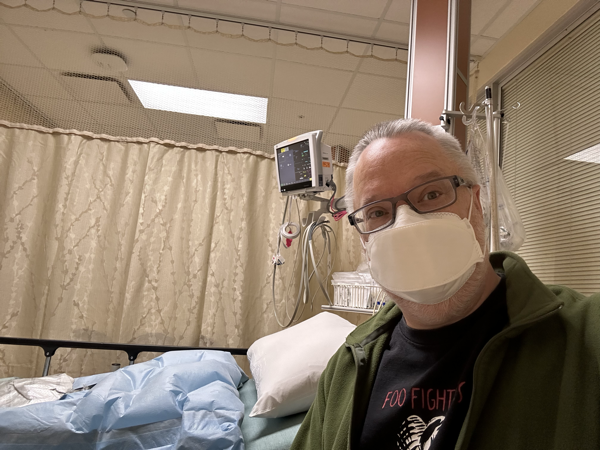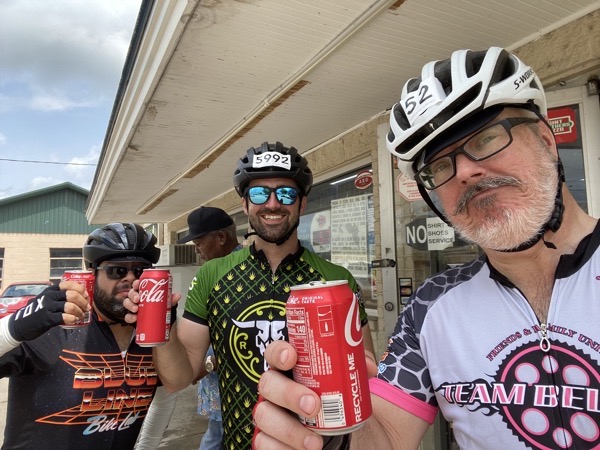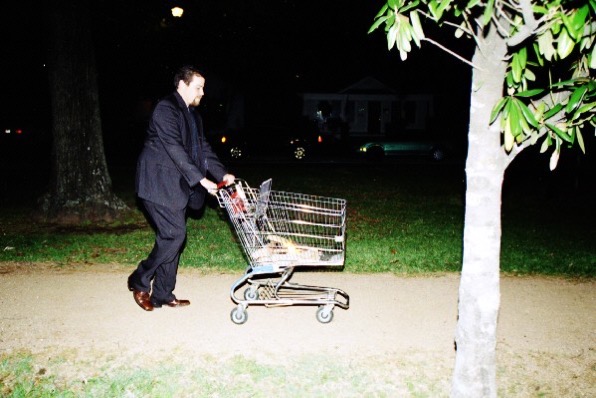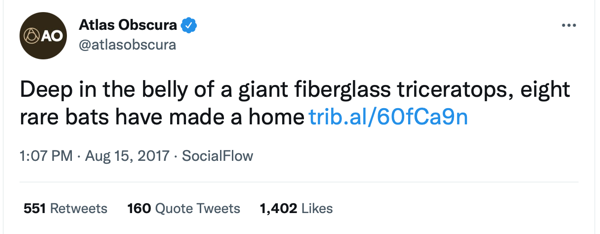Stop Making Sense is coming back to theaters this year with a 4K remaster.
Samsung: Lying Liars who Lie
Samsung phone cameras boast of a fancy “Space Zoom,” and they show it off by taking apparently super detailed pictures of the moon from Earth.
Turns out, though, it’s all smoke and mirrors.
Check it out. The long and short of it is someone thought this looked too good to be true, so he captured a deliberately blurry and detail-free photo of the moon, displayed it on his computer screen, and then took a picture of it with his Samsung.
Samsung’s camera identified it as a picture of the moon — and then basically replaced the image with a manipulated high res picture pulled from somewhere else and doctored to look like an actual capture.
Samsung is not covering itself in glory here; they’ve been constantly prevaricating and providing “blurry” answers when challenged, and even at one point said something that seems demonstrably false:
In 2021, Input Mag published a lengthy feature on the “fake detailed moon photos” taken by the Galaxy S21 Ultra. Samsung told the publication that “no image overlaying or texture effects are applied when taking a photo” but that the company uses AI to detect the Moon’s presence and “then offers a detail enhancing function by reducing blurs and noises.”
Except, if you start with a shitty, blurry photo, there are no details to enhance, and no “noise” to remove. If you end up with a sharp picture, then the details have been supplied by the camera, not reality. That’s lying.
This is some high-quality Lego nerdery right here
Books of 2023, #6: Nina Simone’s Gum, by Warren Ellis
First: the musician, not the comic book author. Yeah, it’s weird that there are two niche-famous artists of roughly the same age, and who likely share no small number of fans. The world is weird. (I have ended migrating from a fan of the latter into being a fan of the former, for lots of reasons.)
THIS Warren Ellis is the one famous as Nick Cave’s primary collaborator in the Bad Seeds (see note), Grinderman, and for film score work (most recently on Blonde); Ellis himself also has a band called Dirty Three. He’s a multidisciplinary creative, but he had not yet ventured into the written word (unlike Cave, obviously).
Like many musicians — and people! — Ellis has musical idols and influences that he venerates. Perhaps the most significant for him, it seems, was Nina Simone, but he only ever got to see her perform fairly late, at a festival curated by Cave in 1999, only four years before she passed away.
At the end of her (apparently triumphant, transcendent) performance, Ellis noticed that she’d left her chewing gum on the piano, and on a lark wrapped it in a towel and kept it. In that moment it became a modern relic, in the religious sense; Ellis kept it safe for 20 years, wrapped in that towel and kept in an aging bag from Tower Records, before it became clear that it should be included in the Nick Cave-focussed Stranger than Kindness exhibition in Copenhagen (it’s touring, but there are no plans for a US stop).
This book is part memoir, part discussion of relics, and part the biography of the relic after it emerged from the Tower bag. It is completely delightful, and you should read it even if you’re not a Nick Cave fan. For a book like this, there are no spoilers, so let me include for you Ellis’ final paragraph:
The world you create inside is mirrored outside. Release your ideas and let them land on others’ ears. Enter their hearts. They need them to take flight. Keep the sacred and magical close, and don’t listen to people who tell you it isn’t true. Create your gods, and they will watch over you.
Note: The Bad Seeds released their first record in 1984. Like most long-running bands, has had a number of lineup changes over the years, but a real changing the of the guard happed in 2009, when Cave’s initial main crony Mick Harvey left the band. Ellis stepped into the gap, and the records since then (starting with Push the Sky Away in 2013) are pretty different and, by my lights, suggest a pretty huge artistic and musical leap. The Bad Seeds followed it with the “Arthur” records made in the wake of the loss of Cave’s son: Skeleton Tree and Ghosteen. Both deal mostly (and beautifully) with grief and faith, and which are astonishing documents in and of themselves.
Books of 2023, #5: Dr. No, by Percival Everett
There’s nothing I can tell you about this book that would be an exaggeration. It’s fucking AMAZING — no surprise, really, given that Everett has become a bit of a big deal in recent years.
Our hero is a mathematician who studies nothing. He is the world authority on nothing. He spends all day doing nothing, and nothing comes from it.
He is contacted by a wealthy man who aims to become a supervillain. He believes nothing will allow him to achieve his dreams. Our hero accepts employment with the plutocrat, and madcap hilarity (of a dark sort) ensues.
Everett’s book here is lighter in tone than The Trees, which I read last year (and which was shortlisted for the Booker), but still retains the deadpan lunacy that Everett brings to his work. I can’t suggest this book (and his others) enough. It’s an unalloyed DELIGHT.
This surprises exactly no one
Who’s Got an EGOT?
Viola Davis made history last night by becoming just the 18th person to achieve “EGOT” status: she’s won an Emmy, a Grammy, an Oscar, and a Tony.
What’s interesting about the list is how few of these folks are household names — probably because composers and musicians have an inside track here:
Richard Rodgers, of Rodgers & Hammerstein fame, was first.
Helen Hayes, actress
Rita Moreno, actress. My favorite thing about her EGOT status is that she clinched with an Emmy for the Muppet Show.
John Gielgud, actor (though he won a Tony in 1961 for direction after already achieving his EGOT).
Audrey Hepburn, actress (though her Emmy was from a program where she appeared as herself)
Marvin Hamlisch, composer
Jonathan Tunick, composer
Mel Brooks, comedic actor, writer, and director.
Mike Nichols, mostly a director, but his Grammy was for comedic performance
Whoopi Goldberg, comedian and actress, also won a Tony as a producer
Scott Rudin is the first person to achieve this as a producer only. He is also, it should be noted, an enormous asshole.
Robert Lopez, songwriter. Lopez was also the fastest to get there (10 years), and the youngest (39).
Andrew Lloyd Webber, composer and titan of musical theater
Tim Rice, lyricist
John Legend, singer, songwriter, and producer. He hit the EGOT in the same moment as Rice and Webber, as they were all honored for a live TV production of Jesus Christ Superstar in 2018.
Alan Menken, composer
Jennifer Hudson, actress and producer, and youngest female winner
Viola Davis, actress
Note that the list doesn’t count you if one of your awards is non-competitive (e.g., lifetime achievement or other special sort of award). These folks have the four awards, but one of them’s non-competitive:
- Barbra Streisand (Special Tony)
- Liza Minelli (Grammy “Legend”)
- James Earl Jones (Honorary Oscar)
- Harry Belafonte (Academy Humanitarian Award)
- Quincy Jones (Academy Humanitarian Award)
In all these cases EXCEPT Jones, the “special” award was the clincher; for Q, he clinched with a competitive Tony in 2016 after his Humanitarian Oscar in 1994. Obviously, he’s got some Grammys — 28 of them.
(There’s also the notion of the PEGOT, which adds the Pulitzer to the mix; only Rodgers and Hamlisch have this honor, but it’d be foolish to bet against Lin-Manuel Miranda getting there given that he lacks only the Oscar at this point.)
I can already see the memes coming
I’m not sure when this was announced, but: Austin Butler is playing Feyd Rautha in Dune 2.
This is a pretty key role, and much was made of the fact that there was no casting news about it for the first installment, largely because there was no need to show him in the first half of the story, I reckon. Feyd is the nephew to the Harkonnen duke and primary antagonist, and is positioned in the narrative as a sort of anti-Paul. In the 1984 film, Sting played him as if there were no such thing as overacting. (Not for nothing, Butler is the same age now that Sting was in 1984, which is in line with the rest of the primary cast choices I mentioned here last year.)
Given Butler’s recent fame from the titular role in Baz Lurman’s Elvis, it’s easy to imagine the sort of nutbird mashups we’re likely to get, and for once I’m here for it.
Books of 2023 #4: Far from the Light of Heaven, by Tade Thompson
I don’t actually remember why I pulled down the sample on my Kindle, but the other night I finished another book, and found it, and thought “hell, why not read it?”
Yeah, that was a mistake. This is pitched as a locked-room-mystery space opera, but holy hell it’s a mess. There’s way too much extraneous plot, way too many characters without enough to do, and a really muddled ending. It’s very much a chain of Exciting! Plot! Developments! that are generally unearned, and when reveals happen they’re muted and not terribly interesting. I mean, sure, introduce an interstellar conspiracy 2/3 of the way through the book; why not?
This one’s the first one in a long time that reminds me of a quote usually attributed to Dorothy Parker: “This is not a novel to be tossed aside lightly. It should be thrown with great force.”
Books of 2023 #3: Hell Bent, by Leigh Bardugo
Early last year I read the first Galaxy Stern book (Ninth House) based on a shelf talker at Brazos. It was fine — not the best thing I read last year for sure, but a solid gentleman’s B. And it was definitely good enough to have me jump on the sequel more or less as soon as it popped up as available on my Kindle.
I should take this as a lesson, though, because we all know Amazon is evil, and that you should buy your books locally, and I even have a great outlet for said, but sometimes we are weak. And this time, my weakness was punished with a real overwrought mess of a sequel.
I think Bardugo is pushing for a series here, and why not? I mean, that’s clearly where all genre is going — just try finding a self-contained book at this point. Ninth House had its charms, despite being very trope-driven: underprivileged young woman plucked from dangerous circumstances to attend fucking YALE on a scholarship, but the catch is she has to serve in something called Lethe: a super-secret society that monitors the magical pursuits of the OTHER secret societies on campus. And, wouldn’t you know it, murder and mayhem ensue.
It even ends on a bit of a cliffhanger, but if I’m honest that wasn’t why I went ahead and read the second one; I had enjoyed, at least to a point, the company of Alex Stern and her Lethe cohort, so I was interested enough to buy the sequel on my Kindle at 10:30 at night.
As I said, mistake.
Bardugo has shoved just entirely TOO MUCH STUFF into this book. There are too many plot points, too many new magical ideas pulled out of hats with very little prior justification, too many new characters, and entirely too much empty peril for Stern — whom we know is garbed head to toe in Plot Armor. Moreover, the book needed a MUCH more ruthless editor; we’re burdened repeatedly by needless backstory for minor characters, none of which does much besides increase the page count.
I don’t think I’ll be back for the all-but-inevitable follow-up books.
Let’s blog books again. 2023 #1: The World We Make by N. K. Jemisin
I’ve been a fan of Jemisin‘s work since before she was a Genius, so it’s no surprise I was VERY VERY enthusiastic about the sequel to 2020’s The City We Became, and snagged it as soon as my local shop had a copy.
I’ll be honest and say I didn’t love The World We Make QUITE as much as City, but it’s a minor distinction. She lands the tale well, especially considering that she’d intended a trilogy and pivoted to duology while writing the followup.
Since it’s a sequel I can’t really say much without getting all spoilery, but if you’re a fan of her work, definitely read these two.
New Hip + 10
Ten days ago, on 9 January, I showed up at Memorial Hermann’s Ortho Hospital at five goddamn o’clock in the morning, taking my last steps on a hip that looks like this. It was still dark.

I was no small amount of nervous. Sure, I had much more invasive surgery 8 years ago, when the initial repair happened, but it was on an emergency basis; I had no time to ruminate over it. This time it was a countdown for a month and a half, since we’d decided to push it off until after the holidays.
I can’t decide if it was disconcerting or calming that, for them, it was just another Monday. Total hip replacements are a dime a dozen now; the procedure itself usually takes less than 2 hours. So we were there, and we did a brief amount of paperwork, and then I went upstairs for prep.

I joke that, at this point in the process, I was probably cleaner than I had ever been, and this is because for scheduled surgical procedures in this era of infection, they have you scrub the bejesus out of yourself the night before with super-strong antibacterial soap and a sterile, hospital-issued sponge — and then get up on the day of the procedure and do it again. The stuff was harsh, and my skin felt weird, but I guess the weirdness tells you it’s working.
BUT WAIT THERE’S MORE, because as soon as I was upstairs in a prep area, my first task after stripping was to — you guessed it — wipe my whole person down AGAIN with antibacterial wipes.
I say that; ACTUALLY the first memorable task for ME in that moment was this:

For about 18 months, I’ve had a lift in my left shoe, owing to the gradual but serious bone loss at the top of my left leg. That’s why I’ve limped; that’s one reason I’ve needed a cane since Christmas 2021. And one key change on deck for January 9 was the re-levelilng of my legs, so this little bastard gets to go into a landfill somewhere. Good riddance.
What followed as the usual rigmarole of blood draws and IV lines and etc. I had few moments to myself, but it did seem proper in 2023 to commemorate with a final pre-surgical old-hip selfie:

Then? Well, then things get fuzzy. The anesthesiologist came in and started prepping me for the spinal block, and the main nurse came back and hit me with a couple things in the IV, one of which was Versed which, among other things, interferes with memory. By this point Erin was with me, and tells me I was saying I wanted to remember as much as possible, but nothing is really clear past the moment I expressed anxiety about the process of the spinal block. There are fragments. I think I remember being wheeled down the hall and into the actual OR, but it’s really fuzzy.
From my perspective, I blinked, and I was waking up in the recovery area, mildly confused. The same nurse saw me and said “Yep, it’s all over! You did fine!” I should note that, surgically speaking, it really WAS a blink, because as mentioned above a THR is now routinely a sub-2-hour process. That blows my mind, but I could see a clock from my bed and it was only about 10:30AM at this point, and by then I was lucid enough to, well, look at a clock and remember the time.
I ate ice chips for 90 minutes or so as they monitored me, & especially my blood pressure, and by noon they were wheeling me into a private recovery room where Erin was waiting.

Now the full court press started: a THR is now an outpatient procedure, so the goal was to get me out the door before EOD. However, for that to happen, a series of medical providers had to visit, and I had to meet certain postsurgical milestones.
I was visited by — in keeping with the happily-still-lingering season — THREE POSTSURGICAL GHOSTS:
- THE GHOST OF PUTTING ON YOUR SOCKS WITHOUT BENDING OVER: an occupational therapist, who walked me through the aides I’d be sent home with (more later) to work around my immediate movement limitations;
- THE GHOST OF PERPETUAL EXHALATION: a pulmonary person of some sort, who instructed me on the World’s Worst Bong aka the Incentive Spirometer — instruction I didn’t actually need, since this wasn’t my first rodeo with an I.S (it was, however, fun the be able to peg the thing; turns out I do still have some residual cardio fitness);
- THE GHOST OF “FUCK IT LET’S MAKE HIM WALK:” a physical therapist, who got me up and WALKING (using a wheeled walker) while I’m pretty sure my lower half was still drunk — I know for a FACT I was still tipsy from anesthesia because I was struggling to articulate myself with her, which made the whole thing frustrating despite also being successful.
BTW, let me tell you it’s super weird to stand up on a new hip joint and realize that, while you DO have pain — after all, they just CUT YOU OPEN AND EDITED YOUR SKELETON — it’s an entirely different pain, and the pain that’s plagued you for a year from the joint’s deterioration is now gone.
And the whole while the milestones loomed. I had to
- Eat. To that end, I was given the World’s Saddest Sandwich and chips, which was weirdly cruel since with drugs still in my system the combo of “untoasted white bread” and “cottonmouth” was deeply unfun. Even so, eating post-surgery is required because of the number of people who have postsurgical nausea problems. I do not.
- Drink. Same song, different verse. I drank SO MUCH WATER that afternoon, owing I suppose to my assiduous adherence to the presurgical protocol of no food/drink after 9pm the previous night. Normally, I drink a LOT of water, so I was definitely dehydrated — which, of course, complicated the final milestone…
- PEE, because postsurgical kidney function is a thing, too.
I didn’t pee until probably 3:30, but once I had it was as if someone with a mighty clipboard had made the final tickmark, and the Great Medical Machine began the process of disgorging me back to the real world.
The chief complicating factor of this entire affair was the fact that, owing the scar tissue from the entry points of the initial 2014 repair, my surgeon had to do a posterior approach instead of the more modern and apparently less invasive anterior approach. This is all fancy medical jargon, but what it means is “where do you unzip Chet to swap out the parts.” With anterior, the incision would be just inside the relevant hip bone, and down into your groin, but, as stated, this was off the table.
Instead, we went posterior which was through, well, my posterior. (It actually wraps around to the outside of my leg, but that’s the term.) With this approach, enough of the muscular structure is disturbed that there is a real risk of dislocating the implant early on, so my main admonition is DO NOT BEND AT THE WAIST, TWIST, or OTHERWISE STRESS THAT JOINT for at least 6 weeks.
I follow instructions super well, so that’s what we’re doing. Plus, it comes with benefits, such as an insurance-provided long-handled claw grabber that I promise I have not goosed Erin with more than once or twice.
However, in the immediate surgical aftermath, when worries were highest, Erin realized that our sporty little VW was very low to the ground indeed, so she called our neighbor and local Taco Saint Mallory. They have two taller vehicles, so Mallory braved 5:00 traffic to drive over and pick me up in their Grand Cherokee, which was much more comfortable. Then, upon arrival at home, we realized that Mal had also brought a Giant Bag of Tacos in his capacity as a Taco Magnate — along with a paloma for Erin, which was well deserved indeed.
The long and short of it is that the whole affair lasted about twelve hours — the nighttime pic above was taken at 4:53AM; I was at home in my lounge chair by 5PM, taco and Athletic Brewing Free Wave NA IPA in hand. Hilariously, by about 6 I had nodded off in the chair and spilled about 15% of said near-beer, but on a day that could’ve had a shitton more unpleasant mishaps, I’ll take it.
HOWTO: Keep a Diary
My friend Tony kept a diary for ten years.
DominosDominosDominos
In the Netherlands, Dominos delivers pizza using scooters.
They have recently started using electric scooters instead of gas scooters, which, of course, are silent.
There’s been a lot of talk globally about the silence of electric vehicles being a safety hazard, of course, so they modified the scooter to make noise.
All of this is fine. All of this is reasonable. Where it goes ENTIRELY OFF THE RAILS is in what they chose: a human voice that says Mmmmm Dominos Mmmm Tasty while in motion, and just mutters DominosDominosDominosDominos when “idling” at stoplights.
This is FANTASTIC
James Austin Johnson — new guy on SNL — showed up on Fallon, and did a 4 different impressions of Dylan that are completely spot on:
(The fun bit starts at 6 minutes.)
In our ongoing quest to destroy semantic meaning, we provide:
Wallride FTW
I’m not a motorsport person, but I AM a videogame person.
A NASCAR driver (Ross Chastain) just did a Mariocart wall-ride to come from way behind and put himself into the championship. It’s completely bananas.
The principle here is pretty simple: speed is limited by your traction. The rest of the drivers were held to their track by their tires (and aero downforce) alone. By putting his car against the outer wall, Chastain was able to floor it because the wall itself kept him on the track — though obviously at significant cost to the right side of the car.
Here’s coverage; in a postrace interview, Chastain explicitly cites using the tactic in the GameCube NASCAR game as a kid, and figuring it was worth a hail-mary move given the circumstances.
Here’s a longer video showing the move from a variety of angles — this is probably better, because from several you can see how WILDLY faster he was moving in the crucial moments.
The surprising youth of the American founding fathers
Kottke ran a re-run post today noting the ages of the American founding fathers on July 4, 1776.
- Marquis de Lafayette, 18
- James Monroe, 18
- Gilbert Stuart, 20
- Aaron Burr, 20
- Alexander Hamilton, 21
- Betsy Ross, 24
- James Madison, 25
This is less shocking in a post-Hamilton world, wherein we were all treated to a more vibrant, active picture of several of the Founders (even so: Miranda’s original cast had actors older than their characters for Lafayette, Burr, and Hamilton at least), but it’s still striking. Several others, of course, were more “adult” ages:
- Thomas Jefferson, 33 (& not for nothing: Daveed Diggs‘ actual age at the Off-Broadway premiere)
- John Adams, 40
- Paul Revere, 41
- George Washington, 44
- Samuel Adams, 53
And of course:
- Benjamin Franklin, 70.
McKinsey: Just Plain Evil
I remember, when I was younger, being impressed by the “smart people for hire” model of high-end consulting, including and especially McKinsey.
Then, you know, reality intervened. McKinsey has been close to or part of some truly egregious and fucking EVIL things in the last couple decades. The first one people mostly know about was Enron, but it just keeps getting worse.
- McKinsey helped the Sacklers create the opioid epidemic, and then helped structure the bankruptcy settlement hat kept the Sacklers’ billions of ill-gotten gains safe.
- McKinsey helped ICE create the kids-in-cages concentration camps.
- McKinsey helped the Saudi government hunt down dissidents.
The list goes on, but the current example is this: McKinsey is helping a giant nonprofit hospital gouge indigent patients by convincing them they owe money that they explicitly do not. McKinsey advised Providence to train its staff to avoid truthfully answer poor patients’ queries about whether they were eligible for free care.
One of the most haunting details in the Times’ report is the story of Vanessa Weller, a single mother in Alaska, who delivered a premature baby at the Providence Alaska Medical Center. The baby died five days later, but Weller was pursued for $125,000 in medical bills by Providence. As a manager at a local Wendy’s, she was entitled to have her bill erased. Instead, she was relentlessly chased by bill-collectors and her credit rating fell from 650 to 400.
Providence professes to be shocked, shocked, that all this happened. Providence CFO Gregory Hoffman told the Times that the news that his company had failed in its legal obligations after paying a consultant to teach them how to do this “very concerning,” adding that these victimized patients “have our attention.” McKinsey made at least $45,000,000 for designing Rev-Up.
The Times has more.
Working for or with McKinsey is, at this point, morally indefensible. To collaborate with them is to be an enemy of the people.
Kenneth Starr: Dead.
Starr, mostly of note for the sprawling, obscenely expensive and politically motivated investigation into then-President Clinton in the 90s, had a career well beyond that debacle.
For example, he worked in California to support the anti-marriage equality measure Prop 8; he defended Jeffrey Epstein; and he represented mercenary firm Blackwater in a lawsuit brought over the deaths of four civilians in Fallujah. What a guy!
He further covered himself in glory by providing support to child molester Christopher Kloman, a retired schoolteacher ultimately sentenced to 43 years in prison instead of the “community service” suggested by Starr.
It’s hard to say whether his worst final act was the defense of Trump in his Senate trial, or his role in covering up a sexual abuse scandal for the football team while serving as president of Baylor University, but I think we can call it a tie.
Starr died today in Houston, at 76, following complications from surgery.
This is the perfect news bit
It is also, I am informed, a perfect distillation of a certain part of Boston.
How conspiracy-mongering and deliberate ignorance hounded Cecilia Lewis out of TWO jobs
Go read this long piece at ProPublica right now.
The GOP’s hysteria about critical race theory — which, again, is a graduate-level / law-school topic, not something EVER part of K-12 instruction — is completely unhinged, which is exactly the way the GOP likes it. The lie runs ’round the world while the truth is still lacing its shoes, and the Gish gallop of bullshit wins the day for them.
Their pantswetting fear of the 1619 Project and ongoing crusade to make absolutely sure no student is told the unvarnished racist truth of our country’s history is just another step down the road to an Orwellian Ministry of Truth.
I mean, it’s a stone cold FACT that the nation was founded on slavery. Slavery is IN THE CONSTITUTION. When slavery ended, the whites in power waited about 30 seconds before encoding a system of racial apartheid into the country’s laws that persisted until the 1960s. What came after is a legacy of structural racism that is STILL part of everyday American life. You cannot understand America without understanding — or at least trying to understand — the African American experience in this country.
Seriously. Go read Ta-Nehisi Coates’ The Case for Reparations and tell me he’s wrong.
The Republican party is opposed to acknowledging ANY of this. They are the white grievance party now; they openly court white nationalists and place them in positions of power. And their mass of amped-up numbskull followers rally around school boards and engage in ridiculous and vindictive campaigns like the one that caught Lewis.
I would like to remind you all that David Bowie was a wizard
This interview is from 1999, he nails the profound impact of the Internet on global communication and media.
Inbox Excavation: Shit I Meant to Post YEARS Ago
Today in “headlines we won’t click”

SCOTUS to Constitution: Drop Dead
In Egbert v Boule, decided yesterday, the conservative majority ruled that Federal agents are allowed to invade your home and assault you with impunity just as long as you live within 100 miles of the coast or a US border.
Conveniently for law enforcement, 60% of the US population lives in that now Constitution-free zone.
ACLU coverage of the case here, not yet updated for the decision. I expect SCOTUSBlog will be on it before long.
Look what came in the mail.
Do you like watches? I like watches.
Before I was absorbed into Apple Watch Borg, I was a longtime devotee of mechanical wristwatches. There’s something beautiful about them; a mechanical movement is the culmination of tech first used hundreds of years ago. A clockmaker from the 17th century could look inside my Omega and recognize the techniques even if he wouldn’t be able to understand how we got the device so small. It’s a lovely, lovely thing.
But most people have no real idea how they work beyond “uh, I wind it and it keeps time.” I sure hope you are just as delighted as I was when you look over, and hopefully read, this spectacular explainer about how mechanical watches work. It demystifies words like “escapement,” and details clearly, from a very simple and easily understood baseline, how a watch works.
Make time. This is what the web is FOR.
(As a bonus, allow me to point out some other topics the author has given the same treatment — it’s amazing. Gears! Cameras and lenses! GPS! The internal combustion engine! It’s deep-dive paradise! Creating these beautiful, interactive pieces is a hobby for the author, but that doesn’t mean you shouldn’t consider becoming a patron anyway. It’s beautiful work, well done, and authoritative, that helps explain the complex topics around us. In this, he makes the world a better place.)
Your Long-Awaited 2022 MS150 Recap!
FRIENDS!
Over the weekend, I completed my TENTH MS150 ride to end Multiple Sclerosis. I say that, and it’s true that this is the tenth time I’ve been REGISTERED for this ride, but the slings and arrows of outrageous fortune have had their way with this event over the years. To wit:
- 2013: YEAR ONE. I ride a two-day event ending in downtown Austin, but I do it SLOW because I am FAT.
- 2014: Sure, why not do it again? I’m a little slimmer but still very slow. My team masses up just outside downtown to roll across the finish line together, which is EXHILARATING but also a giant PITA for our friends and family waiting at the ACTUAL finish.
- 2015: The weather conspires to take the first day of the event, which is fine because I do not ride, owing to certain medical misadventures, but I still raise money — by now, the mission of the event has taken root in my head, and so fundraising tops $5,000.
- 2016: Participation on the weekend is lower because of threatening weather, but my team saddles up for day 1, the hundred mile route into La Grange. Day 2 is cancelled during Saturday’s ride, which (unfortunately?) opens the door for a seriously epic bash in the campground. Fun was had, but the hangovers were definitely earned.
- 2017: AT LAST a return to the two-day ride plan! We didn’t know it at the time, but this would be the last ride to finish in downtown Austin.
- 2018: I’m a lot stronger, which is fun, and my pals and I knock out the first day in a hair over 5 hours. Day 2 ends at Circuit of the Americas, a huge Formula 1 track outside Austin. This is NOT a great endpoint, but any port in a storm.
- 2019: COTA again, but by now acknowledged as a stopgap. This is my strongest two-day effort, and the only time I felt up to doing the “challenge” route through the state park outside Bastrop. I’m really bummed about that — I probably could’ve done it in ’17 and ’18, but confidence is a bitch sometimes.
- 2020: The ORIGINAL plan for the 2020 ride, released in late 2019, was a reimagining of day 2 entirely. The day one routes and endpoint (La Grange) work well and were retained, but day 2 would bring the ride back east and forsake Austin for College Station. Texas A&M was VERY welcoming, and set up a plan for riders to finish ON KYLE FIELD. The logistics of ending this event in a place like that, which was already engineered to entertain 100,000+ people, were VERY attractive. And then COVID happened. Initially, the ride was pushed to the fall and reduced to a one-day event going to College Station, but that was just wishful thinking. COVID eventually forced a full cancellation.
- 2021: With COVID waning a bit, they tried to do the one-day College Station plan again, but weather eventually forced an 11th hour cancellation. Even so, I hit a personal best on fundraising of over $17,400.
- 2022: Now, finally, we get the full two-day College Station plan. It was, by all accounts a HUGE success!
So if you’re keeping track, out of ten rides, I’ve actually done a 2-day effort only 6 times. Two we lost to due to COVID; one I sat out entirely for medical reasons; and once we lost day 2. Oh well!
- So, Chet, how’d it go this year?
- Great question! Let me tell you.
- You ride a whole bunch! I’ll bet you just ate this up with a spoon, right?
- Well, funny thing about that. It’s true I AM a pretty dedicated rider, and usually notch 100-140 miles in any given week including back-to-back efforts on the weekends, especially this time of year, and largely to prep for this event. But this time around, a crash back in March utterly derailed my training at a critical time. I lost several weeks of those back-to-back efforts, and came into the ride at a lower level of fitness than I wanted.
- Wait. Crash? What?
- Yeah, not a big deal in the larger scope of things — nothing broken, gnarly roadrash, sprained shoulder, etc — but I had to lay off a while. Had it been a month further back, it would’ve made all the difference.
- Quit bitching. You did the ride, didn’t you?
- Damn right. It was just harder than I expected.
- Define “harder”?
- Well, we still kept a solid pace though the start of the hills on day one, but it was slower than in prior years owing to (a) a shared lower fitness with my immediate cadre of pals and (b) the fact that 3 folks made the choice to do the ride on mountain bikes as training for an ultra-endurance event called Leadville later in the year. The gearing on those makes it VERY hard to maintain speeds that are not especially fast on a road bike, but owing to point (a) this was less of an issue.
- Who are these weirdos you rode with?
- Aha! There’s a picture! L to R: Your Humble Author; Amish Mechanic; Everyone’s Favorite Bulldozer Rep; She Who Questioned Her Choices A Bit; Person I Don’t Know Well Enough To Have A Funny Name For; The Charming Axis of Bradford & Cody; The Amazing Returning Cory. (It amuses me to note that there are 5 A&M degrees represented across only 8 folks, but one person is double dipping.)

- Ok, so then what?
- Well, as expected, things got harder for me once the hills hit in Bellville, or about halfway. You can see the elevation graph below; that’s where the Hill Country starts. I am a flatlander, and I am 52 and mildly overweight, and so these are hard for me. But that’s not what made the day suck.

- What DID make the day suck?
- Cramps. I am not, historically, a person who cramps up. I ride thousands of miles every summer in Houston’s tropical humidity and heat, and it really never comes up. I only recently started carrying salt-supplement tablets, and I mostly have them to give to OTHER people. I’m careful about on-bike hydration and nutrition — any long effort is at least partly an exercise in body chemistry; you MUST eat and drink a LOT to ride 100 miles — and so I figured this was a solved problem for me.
Around mile 60, it becamse clear that no, this was NOT a solved problem for me, and that the rest of the day was going to suck out loud. - That sounds bad.
- Yeah, you’re not wrong. The weird thing is that, according to Strava for Day 1, I actually covered the second half of the ride in SLIGHTLY less time than I did in 2019. I have no idea how that could be true, because I felt like CRAP and could only occasionally really put my legs into it; most attempts at any real power would bring back the cramps. But I didn’t sag. I don’t sag.
- What DIDN’T suck about the day?
- The company. Even once I was mostly riding alone, I still ran into my friends on the regular — with the exception of the very HEAD end of folks, we weren’t THAT far apart on the route, and so we’d see each other at rest stops, or pass one another and start riding together again. The suck is ameliorated in good company.
- I’ll bet it felt good to stop!
- Absolutely, but in this case it was very much in the way that it feels good to stop smashing yourself in the head with a ball-peen hammer. I was so wrecked that I gave SERIOUS thought to bailing on day 2.
- But did you die?
- Reader, I did not in fact die. A coke, a beer, a giant jug of electrolyte recovery drink, and a huge plate of Mexican food led directly to about 10 hours sleep, and that helped a LOT. I wasn’t exactly bright eyed and bushy tailed by Sunday morning, but I was no longer in danger of quitting. After all, I had 70 donors watching me via LiveTrack!
- So tell us about day 2.
- Traditionally, day 1 of this ride, at least for stronger riders, is about seeing what they can do. Put your back into it, and drop the hammer, and test yourself. Day 2, on the other hand, is about riding with your teammates and friends, and for that I was GRATEFUL. I rolled out with a small set of pals — mostly the folks enumerated above — and we put some speed out for about 15-20 miles before a few of us decided to drop back and let the stronger ones surge ahead. That triad of folks — me, my pal Bruno, and Eric Cody from day 1 — really ended up doing most of the 80 miles into College Station in some flavor of together. Some of the time it was Bruno pulling me, and some of the time it was me and Bruno pulling Eric, but it was definitely cooperative.
- Did the cramps come back?
- NO, thank God. I had limited power until lunch, but figuring I was probably low on fuel we DID stop at the lunch stop and eat. We don’t normally do this — we skipped lunch on day 1, for example, as we nearly ALWAYS do — but on Sunday, I needed it. This made a huge difference for the back half of the day; I was finally able to put down a little power, and felt good about finishing the ride. Also, lunch pics with BRUNO and ELLENDROTT!


- Anything else?
- Yeah, impromptu breaks helped, too.
- “Impromptu?”
- Yeah, the Society I guess lost the usual day-2 lunch sponsor (HEB), and as such had no drinks other than water or Gatorade at lunch. Eric and Bruno and I, though, REALLY REALY wanted (and had ANTICIPATED) a Coke. (You have NO idea how good a Coke can be on a hot day like that.) As luck would have it, a stopped freight train not long after lunch left us idle for a few minutes in front of a gas station, and so…

- Let’s talk about momentum
- That’s where we find ourselves after the Cokes. We were over 50 miles into what we thought was an 80 mile day, so definitely on the downhill side. (Turns out, it was 85 miles, the extra 5 wasn’t on our radar until later.) Plus, the elevation gains for this ride were actually mostly behind us, which we knew, and which made us feel a LOT better.

- How about that finish?
- It was, as expected, pretty damn awesome. A&M has every right to be proud here; they rolled out the red carpet for us. The ride literally finished on the football field. We did a “victory lap” around the field, and my name was announced (in my capacity as a top fundraiser) while Erin and other friends already finished cheered for me. That was pretty darn nice, and WAY better than the ending experience at either COTA or downtown Austin.

- And what about the REST?
- Well, there is one other thing. This year, I topped $100,000 in lifetime fundraising for this event. If you’re reading this, there’s a very very good chance you’re a part of that. Your support means the world to me, and it WAS that support that kept me rolling when things were going poorly for me on Saturday. I thank you, and the Society thanks you.
Ken Paxton is a craven, evil, jackass
The new anti-trans opinion from the office of our criminally-indicted AG here in Texas directs the Texas Department of Child Protective Services to treat gender-affirming care as child abuse.
Caught in this fascist dragnet are innocent families doing their best to raise their children with love, including the Briggle family in Denton. The Briggles are interesting here because, in the wake of some bathroom bill nonsense 5 years ago, they invited Paxton to dinner on the theory that perhaps actually KNOWING some trans people might matter. He even came!
Spoiler: It did not matter to Paxton. It does not matter to Paxton that trans children are at DRASTICALLY higher risk for suicide and self harm. It does not matter to Paxton or Abbott or any Republican that steps like ones they’re taking INCREASE those risks. No, none of this matters to them because they do not actually care about trans people one way or another.
All they care about is riling up their increasingly reactionary and dangerous base. They need an inflammatory issue to drive voter turnout, and the vanishingly small minority that is the trans community is a convenient target.
This is, I think, even WORSE than them being simply bigoted assholes. I mean, I think they probably ARE bigoted assholes, too, but the absolutely craven and monstrous disregard for the lives of real, actual people here is breathtaking, and it has real-world consequences.
If you vote for this man, or any of his cronies, you are dead to me.
Our Increasingly Gibsonian Future: Robot Dogs Hunt Migrants at the Border
DHS’ choice of vendor sparked additional concern. While most police departments leased their pups from Boston Dynamics, which forbids customers weaponizing any of their tech, DHS chose Philadelphia-based Ghost Robotics. Late last year, the company debuted a version of its robot dogs equipped with long-range guns capable of hitting targets at a reported 1,200 meters.
You’ve seen this before. You should watch it again.
OH NOES! WRONG MAGIC WORDS!
This is fucking hilarious:
A Catholic priest has resigned after a church investigation found he performed invalid baptisms throughout most of his more than 20-year career, according to Bishop Thomas Olmsted of the Diocese of Phoenix.
Father Andres Arango, who performed thousands of baptisms, would say, “We baptize you in the name of the Father, and of the Son, and of the Holy Spirit.” But Olmsted explained the words “We baptize” should have been “I baptize” instead.
Apparently, as a result of the incorrect pronoun, God doesn’t consider these folks properly anointed, and the “victims” will need to get baptized again. BUT THERE’S MORE:
The error also means that because baptism is the first of the sacraments, some people will need to repeat other sacraments, according to the diocese webpage for frequently asked questions. CNN has reached out to the diocese for comment on other sacraments.
Grown adults in the United States are taking this seriously. Jesus wept.
Guess what? CSI is a lie.
That’s the takeaway from this well-sourced piece by Radley Balko that is entirely worth your time.
We’ve all seen stories, both in life and in fiction, about how bad guys got caught by fiber analysis, or bite analysis, or ballistics reports that conclusively prove that a given recovered bullet came from a specific gun, or whatnot. Turns out? None of that is backed by science, and when examined in blind tests the so-called pattern-matching experts tend not to do any better than a 50% accuracy rate. The root of the problem is that these “sciences” have typically been invented by law enforcement to achieve conviction, and those same organizations are DEEPLY unwilling to re-examine the accuracy of these kinds of evidence because, for them, convictions are FAR more important than anything so quotidian as justice.
The current exemplar of this attitude is the assistant general counsel of the FBI crime lab, a guy named Jim Agar, who is actively telling analysts
how to circumvent judges’ restrictions on unscientific testimony. He even suggests dialogue for prosecutors and analysts to recite if challenged. Most controversially, Agar advises analysts to tell judges that any effort to restrict their testimony to claims backed by scientific research is tantamount to asking them to commit perjury.
People are in PRISON over this stuff. People have been EXECUTED. It’s only been with the advent of DNA that the unreliability of pattern-matching evidence has really come to light, which is definitely good news — except one remaining are of pattern matching is not nearly as likely to be disproven by DNA: firearm tracing.
Guns work at a remove. You can shoot someone without being near enough to deposit DNA. And in the absence of DNA evidence to disprove an unethical prosecutor’s pattern-matching-backed theory, you might be up shit creek. Especially since, as the Agar memo shows, law enforcement organizations care far, far more about winning cases than they do about accuracy. Even at the FBI.
This is the best thing you’ll see today
During Prohibition, wineries had a rough path, but at least a few were very, very clever.
They sold bricks of grape juice concentrate that came with a warning that you absolutely should not dissolve them in a gallon of water, seal it up, and store it in a cool, dry place for 21 days, because that would make WINE and doing so would be illegal.
I love this.
Helpful Reminder: Texas is run by criminals
A winter storm is arriving as I type this, and our state government has done NOTHING to prevent the power failures of last winter.
“We could be heroes.”
Take a moment today to remember Bowie, who would have turned 75 years old today. In retrospect, his passing two days after his 69th birthday in 2016 was the point at which everything turned to shit. Next came Prince, and after that, well, Trump and COVID.
There’s lots of ways to remember him. If you have to pick one, you can do a lot worse than “Heroes.”
Another great option is his final album, Blackstar, released on his birthday the year he died. At the time, I thought it was easily among his strongest albums, and the six intervening years have done nothing to change my mind. Listening to it now, understanding that he knew he was dying as he wrote those words, gives it a weight beyond the text.
“Public health is invisible when it works”
Hey, there IS good news re: COVID. Read here.
The tl;dr is that vaccines WORK, and that we probably got a break on omicron. But there’s data on both points that is reassuring.
Does this mean unmask and lick strangers? No, absolutely not. Just keep being careful, and the graphs will keep looking good.
A brief reminder that Jason Isbell is a mensch
This is long, but make time: Jason Isbell is Tired of Country’s Love Affair With White Nostalgia.
BECKETT: Tuesdays on CBS!
This is just beautiful: it’s the proposed credits of a 70s-style crime show starring playwright Samuel Beckett.
American Life Is An Enormous Ripoff
No, seriously. Read this and tell me different.
GenX, drifting well past the midpoint
An unexpectedly sad aspect to the common activity of “whoa! I haven’t thought of $song in years… whatever happened to that band?” is, well, discovering someone who lived in your stereo at some point died a while back.
The first time I remember this happening was a year or so ago, when I randomly heard “How Bizarre” on the radio, and it stayed on my mind enough to Google OMC once I got home. I discovered that Pauly Fuemana, the frontman and singer from OMC, had died in 2010 of a degenerative nerve disease.
I was reminded of this after falling down the Google hole while listening to “Fade Into You” thanks to a BoingBoing post. The song was everywhere in the mid-90s, and honestly it’s never really gone away. Lots of folks probably think of Mazzy Star as a one-hit band, but they had much broader success — just nothing at the scale of “Fade” (but few songs are).
It remains beautiful and ethereal, thanks in part to Hope Sandoval‘s lyrics and delivery, but we ought not overlook her songwriting partner David Roback; all of Mazzy’s output is credited to her for lyrics and him for composition. Roback and Sandoval were the creative center of the band (which, we should note, released three albums AFTER So Tonight That I May See).
So here we are at the point of the post: David Roback — whose career included two other critically-acclaimed LA bands — died last February of metastatic cancer. BrooklynVegan has a roundup of musician responses, which will give you an idea of his influence and reach beyond Mazzy Star. He was 61.
Things we could not possibly make up
Police in Indiana became upset about a teacher’s project on fascism, and shut down the school in protest.
I mean, if the shoe fits…
Is it wrong to plan vacations around bookstores?
Because, I mean, look at this list.
Dept. of Heathen Milestones
Please join me in wishing a happy 50th birthday to a truly OG Heathen & ersatz attorney, Edgar Acosta, seen here in a defining moment from (eek) 20 years ago:

Definitive Proof of the Dangers of Jam Band Music
Phish concert spreads COVID across the entire country.
Over Halloween weekend, the Vermont jam band Phish played a series of concerts in Las Vegas. Several days later, one attendee posted to Facebook that he had tested positive for COVID-19 — and more than 500 replied, most saying that they or someone they knew had also tested positive after attending the concert.
I’ve always thought that Phish a contagion, but this is not how I expected that to manifest.
Marty, just stop
Variety is reporting that Scorsese is planning to direct a Jerry Garcia biopic starring Jonah Hill.
I mean, at least it’s not DeNiro.
Maybe tell a story about something other than boomers.
Realistically, what was the last great Scorsese film? Dude’s been phoning it in for a long time, despite the awards he gets because of the reputation he created with the undeniably great films of the 70s and 80s. I mean, he deserved an Oscar, but he didn’t deserve it for The Departed, which was him coasting through a remake of a Hong Kong film.
This is positively soviet
The GOP really, really hates talking about racism, so in New Hampspire, it’s now illegal — at least in the classroom:
The New Hampshire state legislature passed House Bill 2, the Right to Freedom from Discrimination in Public Workplaces and Education, earlier this year and Sununu signed it into law in June. The bill text says the law “prohibits the dissemination of certain divisive concepts related to sex and race in state contracts, grants, and training programs.” It goes on to describe “divisive concepts” as a number of different things, including ideas like New Hampshire or the United States being “fundamentally racist or sexist” or anything that indicates “an individual, by virtue of his or her race or sex, is inherently racist, sexist, or oppressive, whether consciously or unconsciously.” The passage of the New Hampshire law was part of a broader trend that’s been playing out in red states as Republicans fear-monger about the academic framework called Critical Race Theory, manufacturing outrage about the concept for the better part of the past year.
This is now the official version of “How Soon Is Now?”
By Johnny Marr, with no creaking aging dimwit fascists at all.
I will not be taking questions at this time.
Dept of PERFECT things for GenX Kids
The Saturday Afternoon Ikea Trip Simulator is a text adventure about Ikea. Enjoy.

